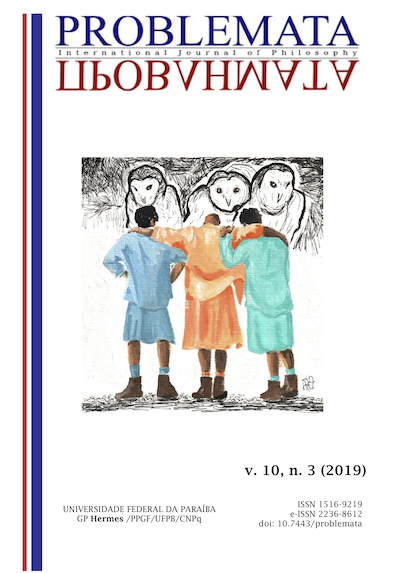THE PHILOSOPHY OF LAW:
BETWEEN DESCRIPTION AND PRESCRIPTION
DOI:
https://doi.org/10.7443/problemata.v10i3.37470Keywords:
Philosophy and Theory of Law, Description and prescription, Facts and valuesAbstract
The object of the present article is to examine the distinction within the philosophy and theory of law between a descriptive approach to legal form, that is, as it examines facts, values and norms, of that other, prescriptive one, which deals with how they should be. The problematic is expressed in a problem by which the object will be inquired, namely, whether the transposition of the world of facts into that of values, without justification, it is possible or whether the humean razor is still methodologically appropriate for the examination of the legal form. The hypothesis, reiterated in independent research by both the author and the co-author, points to its being methodologically more effective in making philosophy of law treat this object as it really is, and not as it should be, even if, in a specific field of moral philosophy, it may be treated prescriptively, but at the cost of examining its being, which can only be done in a philosophically descriptive approach.
Downloads
References
ARISTOTLE. Rhetoric. New York: Dover, 2004
EMPÍRICO, Sexto. Contra os retóricos (edição bilíngüe. Tradução e comentários: Rafael Huguenin; Rodrigo Pinto de Brito). São Paulo: UNESP, 2013
ENGELS, Friedrich. Correspondence Engels - Lafargue. Paris: Éditions Sociales, 1975
FEITOSA; FREITAS. Para uma crítica ao moralismo jurídico sob a perspectiva da filosofia da práxis: A forma jurídica, entre descrição e prescrição. VIII Colóquio Internacional Marx e Engels – CEMARX/UNICAMP.
FINNIS, John. Natural Law and Natural Rights. New York: Oxford University Press, 2011
FREITAS, Lorena; FEITOSA, Enoque. As ilusões referenciais do juspositivismo e do jusnaturalismo a partir de uma leitura marxista-realista da “Antígona” de Sófocles. In: RUBIO, David Sánchez; OLIVEIRA, Liziane; COELHO, Carla. Teorias críticas e direitos humanos: Contra o sofrimento e a injustiça social. CRV: Curitiba, 2016
FREITAS, Lorena. Realismo jurídico como pragmatismo: Acerca da tese realista de que direito é o que os juízes dizem que é direito. João Pessoa: Ed UFPB, 2016
HUME, David. Enquiry Concerning Human Understanding. Jonathan Bennett, 2017
_____. A arte de escrever ensaio e outros ensaios. Iluminuras: São Paulo, 2011
_____. An abstract of a book lately published, entitled “A Treatise of Human Nature”. Gale ECCO, Print Editions, UK: 2010
_____. Tratado da natureza humana: Uma tentativa de introduzir o método experimental de raciocínio nos assuntos morais (1739). São Paulo: Unesp, 2001
_____. A Treatise of Human Nature. London: Claredon Press, 1986
IBRI, Ivo Assad. As conseqüências de conseqüências práticas no pragmatismo de Peirce. In: Cognitio. Centro de Estudos do Pragmatismo – Dept. Filosofia PUC-SP. N. 1. Nov. São Paulo: EDUC; Palas Athena, 2000, p. 30-31; IBRI, Ivo Assad. Kósmos noētós: arquitetura metafísica de Charles S. Peirce. São Paulo: Perspectiva, 1992
JAMES, William. Pragmatism. New York: Dover, 1995
KELSEN, Hans. Teoría Pura del Derecho. Mexico: UNAM, 1991
MARX, Karl. O Capital. São Paulo: Abril Cultural, 1983
MONTAIGNE, Michel de. Os ensaios. São Paulo: Companhia de Letras, 2010
MOORE, G.E. Principia Ethica. Lisboa: Calouste Gulbekian, 1993
PEIRCE, Charles Sanders. How to make our ideas clear. In: Popular Science Monthly. (January 1878).
< http://www.peirce.org/writings/p119.html>.
PESSOA JR., Osvaldo. Contexto de descoberta e de justificação. In: Filosofia da física clássica. São Paulo: USP, 2007
SOFOCLES. Antígona. Porto Alegre: L&PM,
SMITH, Adam. Conferências sobre retórica e belas-letras. Topbooks: Rio de Janeiro, 2008
SOBOTA, K. Não mencione a norma. In: Anuário dos Cursos de Pós-Graduação em Direito, nº 7. Recife: EDUFPE, 1995
TUZZI, Giovanni. Legal abductions. Disponível em <http://www.jurix.nl/pdf/j03-05.pdf>. Acesso em 20 ago 2008
Downloads
Published
Issue
Section
License
Authors who publish with this journal agree to the following terms:
- Authors retain copyright and grant the journal right of first publication with the work simultaneously licensed under a Creative Commons Attribution License that allows others to share the work with an acknowledgement of the work's authorship and initial publication in this journal.
- Authors are able to enter into separate, additional contractual arrangements for the non-exclusive distribution of the journal's published version of the work (e.g., post it to an institutional repository or publish it in a book), with an acknowledgement of its initial publication in this journal.
-
- Authors are permitted and encouraged to post their work online (e.g., in institutional repositories or on their website) prior to and during the submission process, as it can lead to productive exchanges, as well as earlier and greater citation of published work (See The Effect of Open Access).





